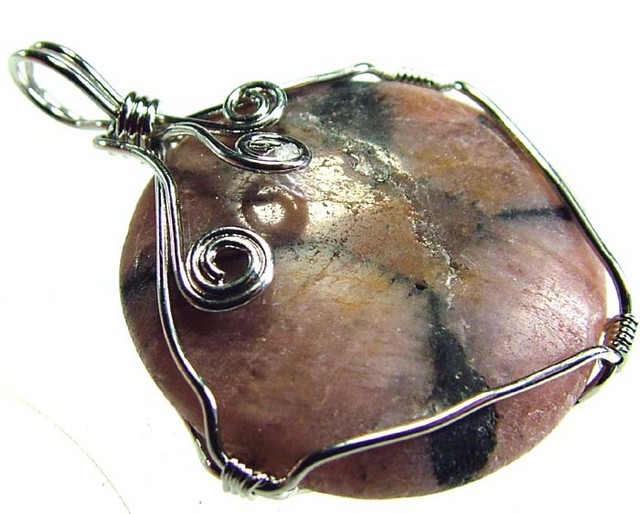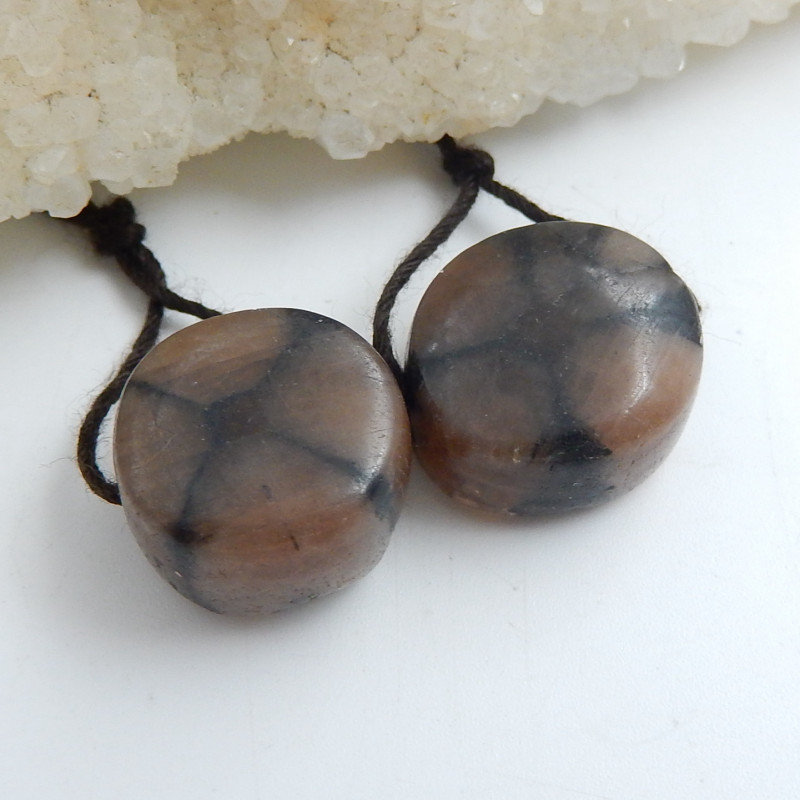
空心石宝石:特性、含义、价值等
 空晶石(发音为 ky-AS-tuh-lyte)是一种奶油色至棕色的红柱石宝石,带有黑色几何十字图案。许多人称空晶石为“十字石”。
空晶石(发音为 ky-AS-tuh-lyte)是一种奶油色至棕色的红柱石宝石,带有黑色几何十字图案。许多人称空晶石为“十字石”。
空晶石和红柱石一样吗?差不多吧。红柱石本身就是矿物,但它也有两种类型:绿柱石和空晶石。所以,每颗空晶石都是红柱石,但并非所有红柱石都是空晶石。
空晶石稀有吗?是的,非常稀有。宝石级的红柱石本身就很稀有,而空晶石更是稀有。
如果您想浏览一些待售的空晶石,或者只是想了解更多关于著名的“十字石”的信息,请跟随我们分解空晶石的所有特性、治疗能力、含义等等!

关于空心石
空晶石通常是一种不透明的棕色半宝石,因其十字形图案而用于装饰。除了“十字石”之外,空晶石的其他名称还包括:
十字花青金石
十字青金石
麦克尔
马耳他石
十字石/十字石
基亚斯托利特
此外,卖家可能会将空晶石标记为“trapiche andalusite”。
由于生长条件特殊,达碧兹宝石大多拥有对称的“辐条状” 内含物,因此十分稀有,备受追捧。其中最珍贵的是产自哥伦比亚的达碧兹祖母绿。
从占星术的角度来说, 空晶石是天秤座和摩羯座的标志。
工业上,红柱石(如空心石)因其优异的耐热性而被用于窑炉的耐火内衬。

空晶石规格和特性
空晶石是红柱石的一种,是一种铝硅酸盐。空晶石的化学式为 Al2SiO5 或 Al2(SiO4)O。除了空晶石,红柱石的种类还包括绿柱石和红柱石本身。
与其他品种相比,空晶石的硬度和密度较低。大多数红柱石的莫氏硬度为6.5-7.5,密度为3.12-3.17。然而,空晶石的莫氏硬度为5-5.5,密度为3.00-3.15。
此外,红柱石还具有强烈的多向色性。虽然大多数空晶石不具有多向色性,但在透明至半透明的薄片中,你可以看到多向色性。
在特拉皮兹宝石中,空晶石的独特之处在于其对称性不高(仅为拟四方晶系)。这种宝石的独特之处还在于它能够形成横截面为方形的棱柱状晶体。它也能形成自形晶体或粒状/放射状集合体。
以下是空晶石的矿物特性:
莫氏硬度:5-5.5
颜色:白色、灰色、黄色、棕色、绿色、棕粉色、绿灰色、棕灰色;黑色、灰色或绿色十字图案
晶体结构:正交
光泽:玻璃状至哑光
透明度:半透明至不透明,很少透明
折射率:1.62-1.64
密度:3.00-3.15
解理: 明显, 单向 [110](?)
断口:均匀至亚贝壳状
条痕:白色
发光:有时出现荧光 - 在短波紫外线下呈棕色或黄绿色
多色性:在薄片或透明标本的核心中可见,但通常无法观察

空晶石的意义和历史
空心石象征着重生、变化和平衡。它也代表着保护和虔诚。它与虔诚的联系,尤其是在精神层面上的联系,跨越了不同文化对空心石精神含义的解读。
另一种有着类似民间传说的矿物是十字石,它与空晶石一样,都被称为“仙女十字石”。几个世纪以来,人们收集这些石头,相信它们那四面八方的十字架蕴含着力量。
一些古代解释认为,空晶石的十字架象征着神的庇佑、幸运符和护身符。它们常被用来抵御邪眼、巫术或厄运。
美洲原住民历史上曾使用空晶石和十字石在仪式中祈求庇护。切罗基部落甚至融入了“Yunwi Tsunsdi”(意为“小矮人”)的传说,他们的眼泪呈十字形。
然而,在历史上,空晶石的主流解释是与基督教的十字架联系在一起的。
早期历史
“chiastolite”这个名字来源于希腊语chiastos ,意思是“十字形”或“对角排列”,因为希腊字母chi与“X”相似。
关于千石棉的第一个记录是荷兰地理学家 Johannes De Laet 于 1648 年出版的《De Gemmis et Lapidibus》 (拉丁语,意为“宝石和石头”)中的一幅图画。
然而,第一个官方描述来自西班牙传教士和古生物学家 José Torrubia,他于 1754 年在他的著作《Aparato para la Historia Natural Española》 (西班牙语,意为《西班牙自然历史仪器》)中发表。
巧合的是,托鲁维亚的描述早于法国矿物学家让-克洛德·德拉梅瑟里 (Jean-Claude Delamétherie) 于 1798 年首次描述红柱石。
从16世纪开始,空晶石最主要被当作宗教纪念品出售,赠予那些完成西班牙圣地亚哥朝圣之路(Camino de Santiago,意为“圣雅各之路”)的人们。圣地亚哥-德孔波斯特拉的基督教朝圣之旅始于公元9世纪,那里有一座位于圣雅各墓上的大教堂。
这个圣地是1000公里旅程的最终目的地,与耶路撒冷和罗马一起,是天主教徒可以前往赦罪的三个地方之一。
在新英格兰的意义
在大西洋彼岸,欧洲分离主义殖民者于 1620 年和 1653 年定居于美国马萨诸塞州。1620 年的清教徒和 1653 年的清教徒群体大多是基督徒。
在如今马萨诸塞州的兰开斯特,殖民者发现了空晶石,并对其神秘、甚至可能神圣的构造深深着迷。他们将空晶石送回英国,在英国皇室中广受欢迎,并被许多英国博物馆收藏。殖民者还将其用作纽扣和饰钉等装饰品。
现代意义
如今,空晶石在西班牙和法国仍然是重要的文化遗产,人们在那里开采空晶石并出售给天主教游客,空晶石通常被抛光并镶嵌在珠宝中。
M. Calvo Rebollar 2016 年的研究详细介绍了千石石在西班牙的当地意义,“El “lapis crucifer”, “piedra de cruz de Compostela”: un elemento importante de los patrimonios geológico y Cultural del NW de España”(西班牙语为“The lapis crucifer”, “stone of the cross of Compostela”:一个重要的元素)西班牙西北部的地质和文化遗产” )。
除了宗教纪念品,空晶石还有什么用途?当然是治病!

千硅石的治疗特性
所有宝石的颜色和振动都使它们成为有用的疗愈石。空晶石常见的棕色和黑色意味着它与其他黑色和棕色宝石一样,能够提供接地、保护和与自然的连接。
然而,许多空晶石的基色是乳白色,因此它们会让人联想到白色宝石的净化和转化特性。此外,灰色空晶石则代表着灰色水晶的平衡与和谐。
空心石对于身体、情感和精神治疗有何益处?
身体康复
从生理角度来看,空晶石有助于治疗:
痛风
血液循环不良
神经损伤
中风患者
肌肉无力
低血压
风湿病
麻痹
进入情感治愈!
情绪疗愈
空心石象征着重生和复兴,使其成为重大转变时期的良伴。它据称能够增强韧性和决心,并具有舒缓作用,因此在人生变化时期格外有用。
此外,据说这种水晶具有抵御负面情绪的保护特性,能带来更强大的内心平静、积极向上的心态和解决问题的能力。水晶治疗师经常向致力于个人成长的人推荐空晶石。
脉轮疗愈
脉轮疗愈包括打开阻塞的脉轮(身体的能量中心),以缓解负面症状。空心石适用于哪个脉轮?空心石是海底轮的石。
海底轮掌管着对安全感和连接感的基本需求。使用空心石脉轮石,你可以将不安全感和孤独感的堵塞症状转化为自信和连接感的平衡症状。

混杂石宝石特性
在确定空晶石的客观价值时,要考虑的最重要的宝石特性是其颜色、切工、净度、透明度和处理方式。
颜色
空晶石最常见的颜色是棕色底色和黑色十字纹。不过,其体色也可能是乳白色、粉红色、灰绿色、灰色或红色。浅绿色至深绿色的空晶石尤其受欢迎。
十字形图案由管状结构组成,有时是直的,表面呈波浪状。由于晶体的棱柱面生长迅速,碳或石墨内含物被推向晶体边缘。有时,空晶石会呈现出波浪状交替的黄色和棕色。
许多卖家认为淡粉棕色是最好的。
切
空晶石很少被刻面,甚至很少被刻面。它通常被切割成凸圆形宝石、珠子、滚石或抛光片。由于每颗空晶石都各不相同,它们可以制成独一无二的珠宝饰品。
有时,你会看到技艺精湛的宝石切割师正在切割空晶石球体。它也可能经过雕刻。

明晰
众所周知,空晶石的独特外观源于碳质包裹体,特别是石墨颗粒,它们形成了几何形状。(没错,就是铅笔里用的那种石墨!)
这并不奇怪,因为红柱石具有 II 型彩色宝石净度等级,因此一些可见的内含物很常见。
然而,空晶石的内含物与其他红柱石品种不同,它提升了空晶石的价值。唯一的缺点是内含物会降低空晶石的硬度和耐久性。
透明度
由于大多数空晶石是不透明的,因此罕见的透明至半透明样品价值更高。大多数空晶石在切片和抛光后会呈现出更高的透明度。
治疗
虽然并不常见,但红柱石样本(包括空晶石)通常经过热处理和/或用树脂填充裂缝。虽然加热不会显著改变颜色,但填充裂缝可以提高宝石的坚固性和清晰度。
接下来,空晶石是如何形成的呢?

杂硅石的形成和来源
总体而言,像空晶石这样的达碧兹矿物最近才被发现,其形成机制尚未得到研究人员的完全认同。然而,最广为接受的理论来自美国矿物学家克利福德·弗朗德尔博士于1934年提出的理论。
弗朗德尔的理论认为,空晶石的“十字”形状是通过不同的生长速率形成的。当空晶石在岩石内部经历变质作用时,晶体的生长速率会随着石墨杂质的浓度增加而降低。
石墨或碳质杂质变成针状晶体,聚集在“凹角”周围,或通常表示孪生晶体相遇的凹痕。
几乎所有的空晶石矿物都存在于富含石墨的变质岩或变质沉积物中。一些空晶石晶体会被钠长石、白云母和珍珠石侵蚀。
那么,空晶石是在哪里发现的呢?
采矿地点
如今,中国湖南省出产最大的空晶石晶体,但西班牙的储量最为丰富。
南澳大利亚州以其独特的带有绿色十字图案的黑色空晶石而闻名。巴西也因出产一些颜色呈粉红棕色至棕粉色的透明空晶石而闻名。
空晶石的其他来源包括:
巴西
加拿大
智利
法国
韩国
缅甸
俄罗斯
斯里兰卡
英国(英格兰、苏格兰)
美国(加利福尼亚州、特拉华州、马萨诸塞州、内华达州)
法国的空心石非常特殊,生长相对丰富,可形成大而形状良好的晶体或半透明的粉红色晶体。

空心石的价格和价值
正如我们所提到的,一些卖家可能会将空晶石标记为“trapiche andalusite”,因此购物时请记住这一点。
价格方面,空晶石凸圆形宝石和滚石的批发价为5至30美元。1670至1930克拉的原石样品价格通常为30至35美元。
像头骨这样的空心石雕刻品价格一般为 50 至 65 美元,而空心石球的价格则在 15 至 130 美元之间,主要取决于尺寸。
空晶石首饰种类繁多,其中戒指和吊坠最受欢迎。首饰价格区间如下:
吊坠:零售价 4 至 200 美元(银质镶嵌,不镶嵌其他宝石);批发价 6 至 20 美元
戒指:5 至 200 美元(银质镶嵌,不镶嵌其他宝石)
耳环:10美元至130美元
串珠手链:20至100美元
袖扣:20至90美元
在我们结束之前,您可能想知道如何保养您的宝石。
空心石的保养和维护
鉴于其相对柔软度和解理度,我们建议购买带有保护性镶嵌的空心石首饰。
您可以使用软牙刷蘸取温和的肥皂和温水混合物来安全地清洁空晶石。请将其远离极热环境和较硬的宝石。

感受空心石的和谐与保护!
十字石、仙女十字石、特拉皮切红柱石——无论您怎么称呼它,空晶石都是一种值得炫耀的宝石,无论是制作珠宝还是收藏。它都是收藏家、历史爱好者和独特宝石爱好者的理想之选!
虽然有些人认为空晶石更像是一种奇特的矿物而非宝石,但这恰恰凸显了它的多功能性。它常常呈现出温暖的秋日色调,但其丰富的色彩范围使其一年四季都能完美搭配任何朴实的风格。
搜索Gemstone Encyclopedia
最新的文章
彩虹格纹日光石是一种长石,由于内部含有各种包裹体,呈现出三种绚丽的光学效应。它绚丽多彩的光泽和格纹图案使其成为收藏家梦寐以求的珍宝!
12th Jan 2026
文章分类
How To's is where you will find helpful articles from gem Rock Auctions on how to cut gemstones, select gemstones and buy gemstones.
9文章数

